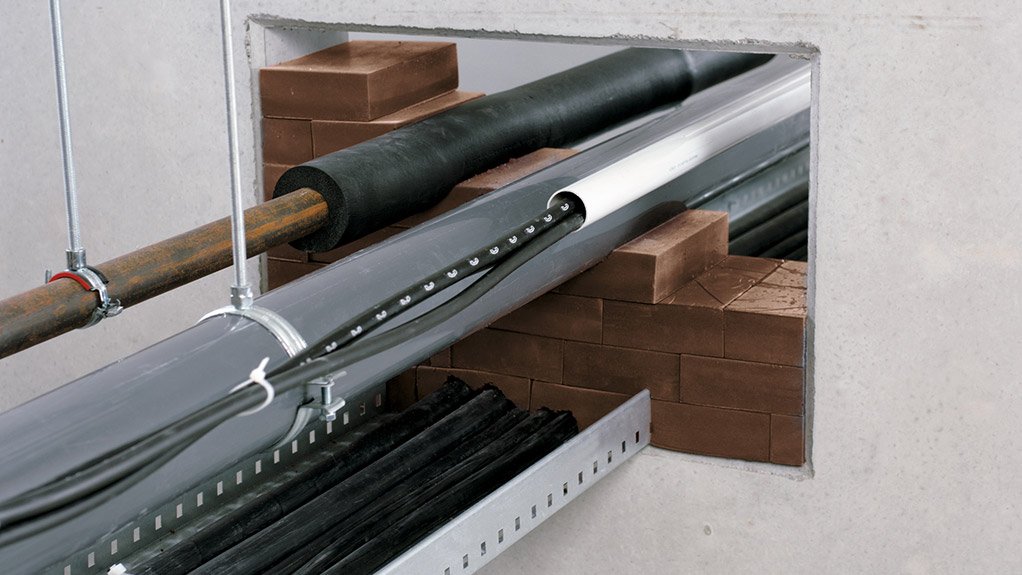Safety in mining is a high priority in South Africa, and the country needs to adopt stricter regulations regarding passive fire protection systems, says global technologies company Hilti South Africa mining business development manager Hector Cerdio.
More awareness should also be created regarding the different fire risks in mining, he says, adding that Hilti South Africa has found gaps in the implementation of passive fire protection systems at all local mining companies.
Hilti South Africa has deployed mining field engineers at local mining companies to conduct safety assessments, where the team has identified a number of fire risk areas – mostly in substations and on conveyor belts.
“In all the mining companies we visited, we found fire detection and suppression systems in place, but there were no passive fire protection systems.”
The Occupational Health and Safety Act does not include any information on passive fire protection, but only emphasises safety awareness and active fire protection measures, such as suppression and detection, Cerdio states.
He points out that mining companies in emerging markets, such as Mexico, Chile and Peru, are forced to comply with the strict regulations on passive fire protection systems, while there is no legal provision to compel companies to implement passive fire protection systems locally.
“All the mining companies we deal with are complying with the existing safety and health regulations, but we believe that more could be done to improve safety in mining, particularly with regard to fire protection systems, rather than just complying with the set of regulations.”
Hilti South Africa was awarded new contracts this year to provide passive fire protection solutions for several South African mining majors, such as Impala Platinum, Exxaro, Glencore, Anglo American and Pan African Resources’ Evander gold mine, in Mpumalanga. These solutions include a firestop barrier on a concrete wall, as well as cable-coating applications.
“We are offering not only a product but also a full technical solution to clients. Our field engineer visits the mine to identify hazardous and risk areas that need to be protected, and specifies which product solution should be used to mitigate the identified risks,” Cerdio explains.
Hilti South Africa product manager for firestop systems Nalen Kuppen emphasises that a passive fire protection system, such as firestop products, provides resistance to the transfer of excessive heat and can provide insulation from high temperatures.
“Smoke tightness should never be forgotten, as smoke is one of the key killers in a fire . . . Smoke travels fast, long before the fire becomes a danger. It will also destroy assets and equipment throughout the building compartments. Therefore, a tight seal on a property must be ensured,” he adds.
He reiterates that explosions and fire in mines can be created from flammable natural gases and combustible coal dust in the air, and that a spark can ignite these gases and particles.
“Electric shock and burns may also occur when high-reaching electrical equipment touches overheard powerlines – this often happens during electrical maintenance work.”
Fire incidents are often caused by shortcuts in cables at substations, friction in conveyor belt systems or workers who burn coal in braziers, he adds.
Cerdio says failure to implement adequate health and safety systems can cause loss of lives, damage to mining assets and result in reduced productivity, subsequently resulting in lower revenue.
He advises that mining companies should install fire suppression and detection systems on conveyor belts and generators, and coat the cables in the processing plants with ablative firestop or intumescent fire-retardant coatings to prevent fire incidents.
Skills and Training
Hilti engineering head Christiaan Davel says the company has been offering safety managers courses, accredited by engineering associations Consulting Engineers of South Africa and the South African Institute of Civil Engineering, since 2015.
Fire engineers, mechanical engineers, mining engineers, mine managers and safety officers can attend the course, and attendees gain a full suite of continuing professional development points.
Training is provided every quarter by Hilti trainers – engineers who have studied further through Hilti abroad, and who have a deep understanding of the subject matter. However, depending on demand, and if a company requests safety training, Hilti South Africa provides such training for the employees of that company, Davel concludes.
Edited by: Mia Breytenbach
Creamer Media Deputy Editor: Features
EMAIL THIS ARTICLE SAVE THIS ARTICLE
ARTICLE ENQUIRY
To subscribe email subscriptions@creamermedia.co.za or click here
To advertise email advertising@creamermedia.co.za or click here













